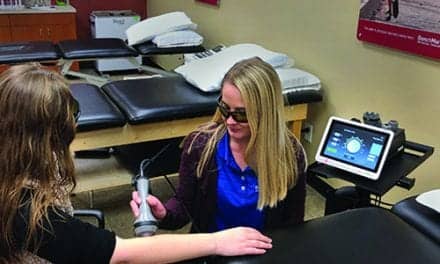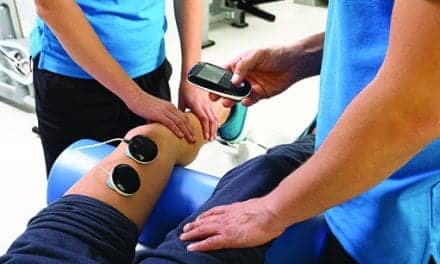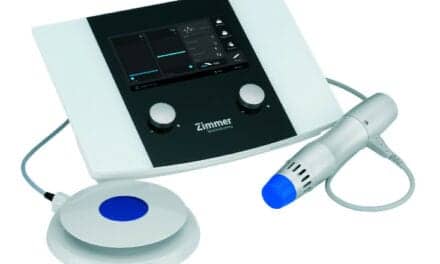By Mark L. Callanen, PT, DPT, OCS
If you have been to a recent health care trade show, you have undoubtedly walked past laser vendors that have made claims that might have caused you to pause or laugh, depending on the day and your familiarity with photobiomodulation (PBM). This article will attempt to provide some clarity regarding how laser impacts pain.
Can Laser Help Reduce Pain and Inflammation?
Yes! Laser therapy is a non-invasive modality that can have effects on acute and chronic pain as well as ameliorate the tissue-repair process.1 Laser therapy stimulates PBM, which is primarily a photochemical process that takes place when mitochondria are excited by a light source.2
PBM is the goal of all laser devices that are intended for therapeutic applications. It is not unique to any single class of laser, nor is the term Low Level Laser Therapy (LLLT), which is another common acronym used to describe therapeutic lasers.2
Laser Classes
In the United States, the FDA defines laser class by the output power of the device. Class III lasers have an output power of less than 0.5 Watts, whereas Class IV lasers have output powers greater than 500 mW or 0.5 Watts. Class IV lasers create heat on the surface of the skin due to their higher power density (irradiance). Class III lasers are often referred to as “Cold Lasers” since they do not create a heating sensation during treatment.
Why is Power Important?
Remembering that energy applied (Joules) = power (Watts) x time (seconds), recent research is showing that applying energy to tissue with high-power lasers impacts tissue differently than applying an equal number of Joules with low-power lasers. This has been shown in studies that compared the two regarding knee OA3 and plantar fasciitis,4 where high-power laser provided more pain relief and better functional outcomes, comparatively. Other studies looking at high-power laser versus placebo have also shown favorable outcomes regarding shoulder impingement5 and low back pain.6
How Does it Work?
Most therapeutic lasers impact pain via PBM’s influence on reducing inflammation around peripheral nerve endings.1,7 However, high-power lasers can reduce pain in minutes by delivering higher irradiance levels to nerve tissue.9,10
This is an important differentiator between high- and low-power lasers. Quick pain relief requires higher irradiance to illicit temporary neuroplastic changes at the neuron. These changes slow the conduction velocity and reduce the amplitude of compound action potentials of both C and A-delta sensory nerves for approximately 24 hours.9,10 These higher irradiances are extremely difficult to achieve in vivo with lower-power devices.
For chronic pain patients dealing with central sensitization (CS) and/or peripheral sensitization (PS), PBM can impact multiple mechanisms related to this pathology. These include normalization of nerve ion channels,11 reducing bradykinin sensitivity which is heightened in chronic pain conditions,12 reduction in mechanical hypersensitivity associated with peripheral nerve injuries,14 and increased Beta Endorphin levels at the dorsal horn.15 All these factors play a role in reducing pain.
A CS mechanism specific to high-power laser involves the relationship between C-fibers and NMDA receptors. NMDA receptors are pain amplifiers within the nervous system that are often targeted by opioid medications. C-fibers have direct input at NMDA receptors within the spinal cord.13 In chronic pain scenarios, C fibers begin to fire more regularly, which eventually leads to increased amplification of the pain signal via NMDA receptors to the brain. Reducing the amount of C-fiber input to the NMDA receptor can potentially curb the up-regulation of the peripheral nociceptive signal.
All PBM reactions require adequate tissue dosing to be successful. Treating with higher power makes this easier to accomplish, especially when treating larger areas, as you can deliver higher amounts of energy in less time.7 This has clinical implications for most busy treatment settings. For example, to treat one side of the L2-S1 erector group at a dose of 10 J/cm2 would require over 30 minutes with a Class III laser, compared to just over 2 minutes with a 15 Watt Class IV laser.
When comparing low versus high-power lasers, the aspects of treatment time, treatment depth, and surface heating have historically been the primary talking points. Recent pain research is suggesting the conversation has pivoted toward the analgesic effects of high-power laser,3,4,8,9 which changes the discussion dramatically. PTP
Mark L. Callanen, PT, DPT, OCS, is the director of clinical development for LightForce Therapy Lasers. He has treated orthopedic patients for 18 years and has been board certified as an Orthopedic Clinical Specialist (OCS) by the APTA since 2003. Callanen earned his doctorate in physical therapy in 2007 from Marymount University. For more information, contact [email protected].
References
1. Cotler H, Chow RT, Hamblin MR, Carroll J. The use of low level laser therapy (LLLT) for musculoskeletal pain. MOJ Orthop Rheumatol. 2015;2(5).
2. Anders JJ, Lanzafame RJ, Arany PR. Low-level light/laser therapy versus photobiomodulation therapy. Photomed Laser Surg. 2015;33(4):183-184.
3. Wyszynska J, Bal-Bochenska M. Efficacy of high-intensity laser therapy in treating knee osteoarthritis: a first systematic review. Photomed Laser Surg. 2018;36(7):343-353.
4. Ordahan B, Karahan AY, Kaydok E. The effect of high-intensity versus low-level laser therapy in the management of plantar fasciitis: a randomized clinical trial. Lasers Med Sci. 2018 Aug;33(6):1363-1369.
5. Elsodany AM, Alayat MSM, Ali MME, Khaprani HM. Long-term effect of pulsed Nd:YAG laser in the treatment of patients with rotator cuff tendinopathy: a randomized controlled trial. Photomed Laser Surg. 2018;36(9):506-513.
6. Vallone F, Benedicenti S, Sorrenti E, Schiavetti I, Angiero F. Effect of diode laser in the treatment of patients with nonspecific chronic low back pain: a randomized controlled trial. Photomed Laser Surg. 2014;32(9):490-494.
7. Huang YY, Chen AC, Carroll JD, Hamblin MR. Biphasic dose response in low level light therapy. Dose Response. 2009;7(4):358-383.
8. Enwemeka CS. Intricacies of dose in laser phototherapy for tissue repair and pain relief. Photomed Laser Surg. 2009;27(3):387-393.
9. Chow R, Armati P, Laakso EL, Bjordal JM, Baxter GD. Inhibitory effects of laser irradiation on peripheral mammalian nerves and relevance to analgesic effects: a systematic review. Photomed Laser Surg. 2011;29(6):365-381.
10. Holanda VM, Chavantes MC, Wu X, Anders JJ. The mechanistic basis for photobiomodulation therapy of neuropathic pain by near infrared laser light. Lasers Surg Med. 2017 Jul;49(5):516-524.
11. Granados-Soto V, Arguelles CF, Alvarez-Leefmans FJ. Peripheral and central antinociceptive action of Na+-K+-2Cl- cotransporter blockers on formalin-induced nociception in rats. Pain. 2005;114(1):231-238.
12. Bortone F, Santos HA, Albertini R, Pesquero JB, Costa MS, Silva JA Jr. Low level laser therapy modulates kinin receptor expression in the subplantar muscle of rat paw subjected to carrageenan-induced inflammation. Int Immunopharmacol. 2008;8(2):206-210.
13. Baron R. Mechanisms of disease: neuropathic pain—a clinical perspective. Nat Clin Pract Neurol. 2006;2(2):95-106.
14. Kobiela Ketz A, Byrnes KR, Grunberg NE, et al. Characterization of macrophage/microglial activation and effect of photobiomodulation in the spared nerve injury model of neuropathic pain. Pain Med. 2017;18(5):932-946.
15. Cramond T, Galligan JP, Laakso EL, Richardson C. ACTH and beta-endorphin levels in response to low level laser therapy for myofascial trigger points. Laser Therapy. 1994;6(3):133-142.






Thanks for explaining that laser therapy is a good non-invasive option to help treat acute and chronic pain. My brother has been struggling with back pain ever since he got in a car accident a couple of years ago, and it’s starting to take a toll on him. I’ll have to tell him to look into clinics that could provide laser therapy to help him feel better.
I’m glad this was helpful to you, Michaela. I’m sure you’ll find a provider in your area and if that doesn’t work out you might want to contact the American Physical Therapy Association to locate someone in your area who provides the service. Best of luck to you!
— Ed.